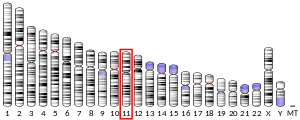| MS4A7 | |||||||||||||||||||||||||||||||||||||||||||||||||||
|---|---|---|---|---|---|---|---|---|---|---|---|---|---|---|---|---|---|---|---|---|---|---|---|---|---|---|---|---|---|---|---|---|---|---|---|---|---|---|---|---|---|---|---|---|---|---|---|---|---|---|---|
| Identifiers | |||||||||||||||||||||||||||||||||||||||||||||||||||
| Aliases | MS4A7, 4SPAN2, CD20L4, CFFM4, MS4A8, membrane spanning 4-domains A7 | ||||||||||||||||||||||||||||||||||||||||||||||||||
| External IDs | OMIM: 606502 MGI: 1918846 HomoloGene: 10922 GeneCards: MS4A7 | ||||||||||||||||||||||||||||||||||||||||||||||||||
| |||||||||||||||||||||||||||||||||||||||||||||||||||
| |||||||||||||||||||||||||||||||||||||||||||||||||||
| |||||||||||||||||||||||||||||||||||||||||||||||||||
| |||||||||||||||||||||||||||||||||||||||||||||||||||
| Wikidata | |||||||||||||||||||||||||||||||||||||||||||||||||||
| |||||||||||||||||||||||||||||||||||||||||||||||||||
Membrane-spanning 4-domains subfamily A member 7 is a protein that in humans is encoded by the MS4A7 gene.[5][6][7]
This gene encodes a member of the membrane-spanning 4A gene family, members of which are characterized by common structural features and similar intron/exon splice boundaries and display unique expression patterns in hematopoietic cells and nonlymphoid tissues. This family member is associated with mature cellular function in the monocytic lineage, and it may be a component of a receptor complex involved in signal transduction. This gene is localized to 11q12, in a cluster of other family members. At least four alternatively spliced transcript variants encoding two distinct isoforms have been observed.[7]
References
- 1 2 3 GRCh38: Ensembl release 89: ENSG00000166927 - Ensembl, May 2017
- 1 2 3 GRCm38: Ensembl release 89: ENSMUSG00000024672 - Ensembl, May 2017
- ↑ "Human PubMed Reference:". National Center for Biotechnology Information, U.S. National Library of Medicine.
- ↑ "Mouse PubMed Reference:". National Center for Biotechnology Information, U.S. National Library of Medicine.
- ↑ Ishibashi K, Suzuki M, Sasaki S, Imai M (Mar 2001). "Identification of a new multigene four-transmembrane family (MS4A) related to CD20, HTm4 and beta subunit of the high-affinity IgE receptor". Gene. 264 (1): 87–93. doi:10.1016/S0378-1119(00)00598-9. PMID 11245982.
- ↑ Liang Y, Tedder TF (Jun 2001). "Identification of a CD20-, FcepsilonRIbeta-, and HTm4-related gene family: sixteen new MS4A family members expressed in human and mouse". Genomics. 72 (2): 119–27. doi:10.1006/geno.2000.6472. PMID 11401424.
- 1 2 "Entrez Gene: MS4A7 membrane-spanning 4-domains, subfamily A, member 7".
Further reading
- Liang Y, Buckley TR, Tu L, et al. (2001). "Structural organization of the human MS4A gene cluster on Chromosome 11q12". Immunogenetics. 53 (5): 357–68. doi:10.1007/s002510100339. PMID 11486273. S2CID 21846867.
- Gingras MC, Lapillonne H, Margolin JF (2001). "CFFM4: a new member of the CD20/FcepsilonRIbeta family". Immunogenetics. 53 (6): 468–76. doi:10.1007/s002510100345. PMID 11685457. S2CID 29981957.
- Xu XR, Huang J, Xu ZG, et al. (2002). "Insight into hepatocellular carcinogenesis at transcriptome level by comparing gene expression profiles of hepatocellular carcinoma with those of corresponding noncancerous liver". Proc. Natl. Acad. Sci. U.S.A. 98 (26): 15089–94. Bibcode:2001PNAS...9815089X. doi:10.1073/pnas.241522398. PMC 64988. PMID 11752456.
- Strausberg RL, Feingold EA, Grouse LH, et al. (2003). "Generation and initial analysis of more than 15,000 full-length human and mouse cDNA sequences". Proc. Natl. Acad. Sci. U.S.A. 99 (26): 16899–903. Bibcode:2002PNAS...9916899M. doi:10.1073/pnas.242603899. PMC 139241. PMID 12477932.
- Ota T, Suzuki Y, Nishikawa T, et al. (2004). "Complete sequencing and characterization of 21,243 full-length human cDNAs". Nat. Genet. 36 (1): 40–5. doi:10.1038/ng1285. PMID 14702039.
- Gerhard DS, Wagner L, Feingold EA, et al. (2004). "The status, quality, and expansion of the NIH full-length cDNA project: the Mammalian Gene Collection (MGC)". Genome Res. 14 (10B): 2121–7. doi:10.1101/gr.2596504. PMC 528928. PMID 15489334.
- Otsuki T, Ota T, Nishikawa T, et al. (2007). "Signal sequence and keyword trap in silico for selection of full-length human cDNAs encoding secretion or membrane proteins from oligo-capped cDNA libraries". DNA Res. 12 (2): 117–26. doi:10.1093/dnares/12.2.117. PMID 16303743.
This article is issued from Wikipedia. The text is licensed under Creative Commons - Attribution - Sharealike. Additional terms may apply for the media files.



